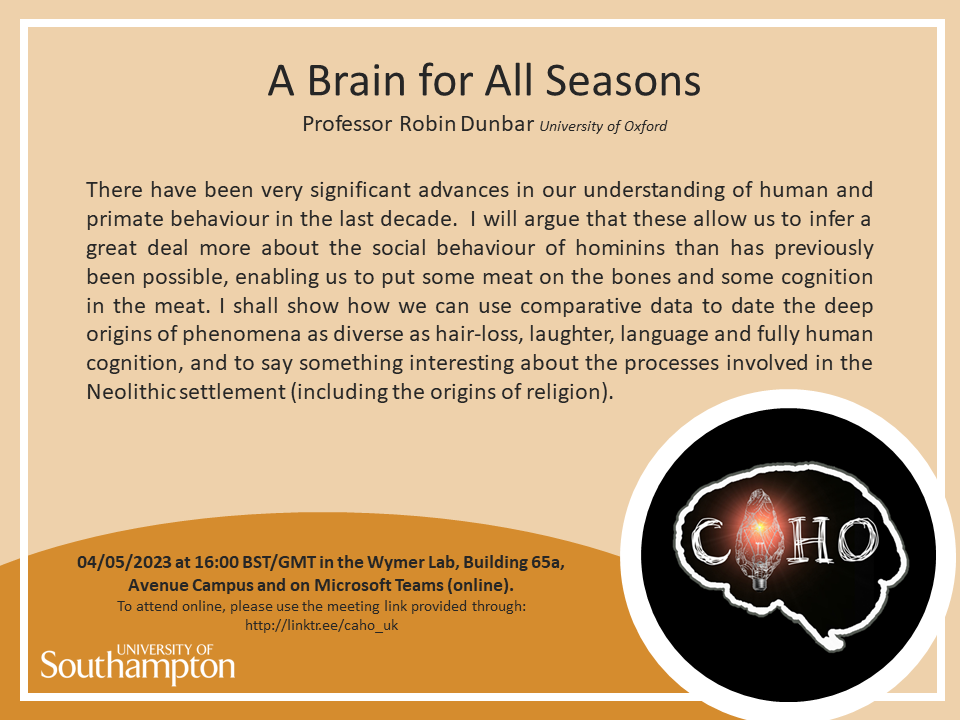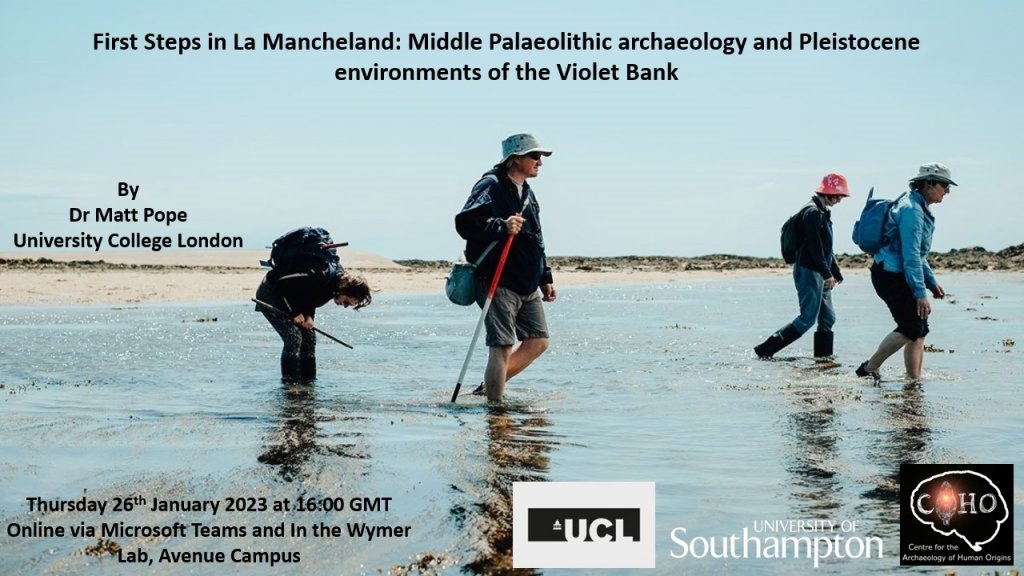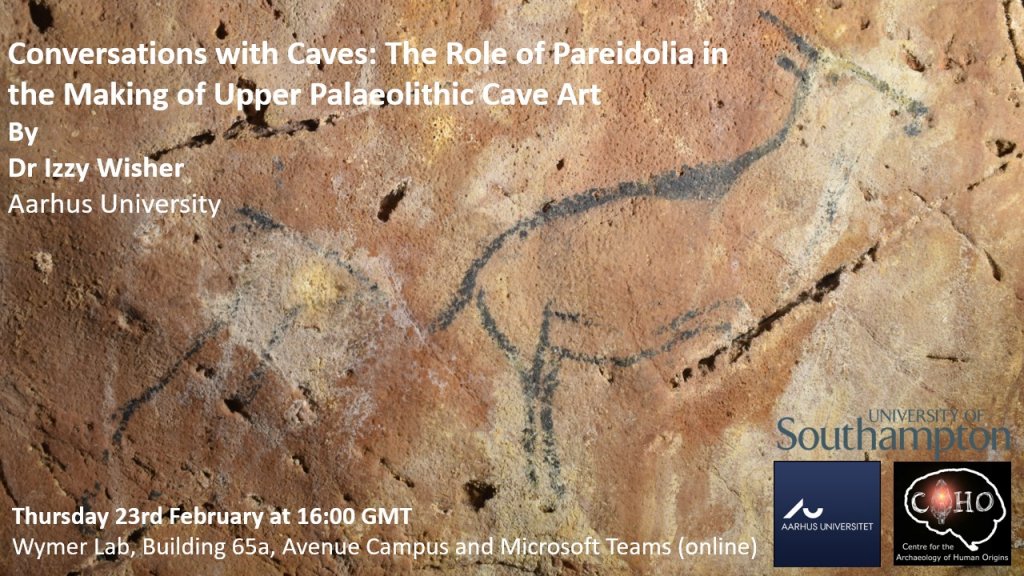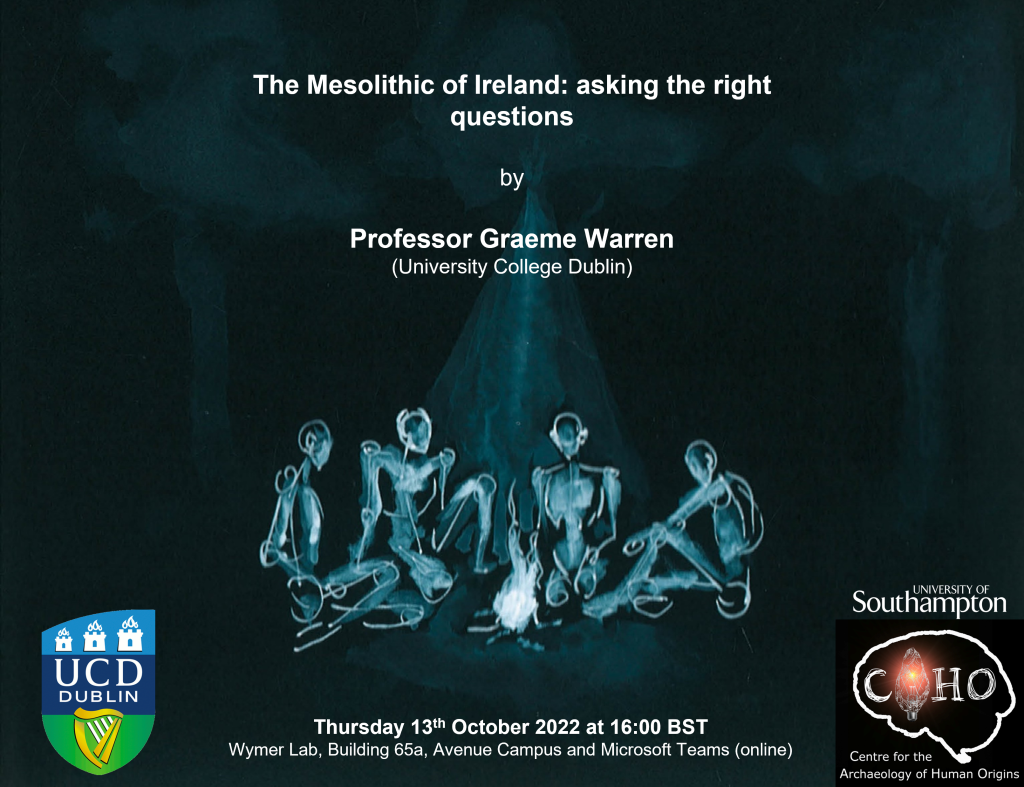CAHO Seminar Series 2022-2023 Programme
Summer Term
The CAHO Seminar Series welcomes you to the final instalment of talks for the 2022-2023 academic year. Check out the posters below for further details.
If you are interested in joining us for the CAHO Seminar Series each week, please use the following Microsoft Teams meeting link: Click here to join the meeting.
4th May 2023
Professor Robin Dunbar (University of Oxford)
Title: A Brain for All Seasons
Abstract: There have been very significant advances in our understanding of human and primate behaviour in the last decade. I will argue that these allow us to infer a great deal more about the social behaviour of hominins than has previously been possible, enabling us to put some meat on the bones and some cognition in the meat. I shall show how we can use comparative data to date the deep origins of phenomena as diverse as hair-loss, laughter, language and fully human cognition, and to say something interesting about the processes involved in the Neolithic settlement (including the origins of religion).

18th May 2023
Professor Jan Kolen (Leiden University)
Title: How old is human dwelling?
Abstract: Now it increasingly becomes clear that Neanderthals’ environmental tolerance was large and flexible, covering semiarid (Mediterranean), wet (marine) and cold (subarctic) conditions, it must be assumed that Neanderthals must have had effective and sustainable strategies for organising shelter. However, this does not necessarily mean that Neanderthals created comparable forms of architecture as recent hunter-gatherers living under similar conditions. From an ethnographical and historical perspective, recurrently used and roof-covered dwelling structures with a clear ordering of internal and external space, either transportable or spatially fixed, provide the generally accepted model for archaeological inference and explanation. Many Neanderthal sites indeed contain patterned, circular or semi-circular structures that remind of this model. Several of these have long taphonomic histories that may indicate (partial) post-depositional origins. Others reflect convincing examples of the structured use of space that are nonetheless enigmatic from a conventional perspective on human architecture and dwelling.
In this paper, we explore alternative frameworks for understanding patterned structures at Middle Palaeolithic sites, emphasizing idiosyncracies in Neanderthals uses of landscape, space and place. The question will be raised when in human history the first roof-covered dwelling constructions may have appeared and why, and what characterized human architecture before that time.
Spring Term
The CAHO Seminar Series are pleased to announce the programme for the Spring Term of our 2022-2023 programme. To find out what we have in store for you, please check out the programme summary in the poster below.

If you are interested in joining us for the CAHO Seminar Series each week, please use the following Microsoft Teams meeting link: Click here to join the meeting.
For further information on the abstracts and posters for each talk, please see the details below.
26th January 2023
Dr Matthew Pope (University College London)
with Martin Bates, Chantal Conneller, Letty Ingrey, Sarah Duffy and Ed Blinkhorn
Title: First Steps in La Mancheland: Middle Palaeolithic archaeology and Pleistocene environments of the Violet Bank
Abstract: The Violet Bank is a granite reef located on the south east corner of Jersey. On extreme low tides the reef is exposed up to 4.5km from the modern coast allowing an area of the seabed to explored on foot during short tidal windows. The reef is dissected by gullies extending into localised basins, both of which retain head deposits from the Pleistocene. The potential of these deposits to provide an archive of former terrestrial environments was first demonstrated through the discovery of a mammoth tooth, 1km from shore, by Dr Arthur Hill of the Société Jersiaise and since then, particularly in the last five years, stone artefacts of clear Middle Palaeolithic character have begun to be recovered. The Violet Bank Survey, funded by the British Academy and Leverhulme Trust, has been developed to initiate more systemic prospection for evidence of past human activity, and sedimentary records, preserved in this vast inter-tidal landscape. We present the results of our first season of survey and consider how results can inform our understanding of terrestrial sites like La Cotte de St Brelade, as well as consideration of early activity in the wider La Manche region.

9th February 2023
Professor Jan Kolen (Leiden University)
Title: TBC
Abstract: TBC
23rd February 2023
Dr Isobel Wisher (Aarhus University)
Title: Conversations with Caves: The Role of Pareidolia in the Making of Upper Palaeolithic Cave Art
Abstract: Cave art was a diverse phenomenon in the Upper Palaeolithic, with a breadth of abstract signs and schematised or detailed animals depicted deep in cave environments. The relationship between cave wall topographies and depictions has been central to interpreting this art, and in recent years there has been an increasing appreciation of the dimensionality and materiality of Upper Palaeolithic cave art. Figurative depictions in particular appear to deliberately incorporate topographic features, such as undulations, cracks and fissures. Focusing on two cave art sites in northern Spain – Las Monedas and La Pasiega – this talk explores how the integration of natural features may reflect certain visual psychological processes at work within the making of figurative cave art. In particular, pareidolia – the phenomenon of seeing meaningful forms in random patterns, like faces in clouds – appears to have been a central mechanism that underpinned Upper Palaeolithic art making. Using 3D modelling and Virtual Reality, hypotheses related to the role of pareidolia in Upper Palaeolithic art making were tested. From these results, it is proposed that these pareidolic responses, where artists perceived animal forms in cave wall topographies, facilitated different artist-cave interactions (or “conversations”), with shifting tensions in agency occurring during art making.

9th March 2023
Sam Hudson (University of Southampton)
Title: TBC
Abstract: TBC
Autumn Term

13th October 2022
Professor Graeme Warren (University College Dublin)
Title: The Mesolithic of Ireland: asking the right questions
Abstract: This paper provides an overview of some key aspects of the Mesolithic in Ireland, drawing on detailed case studies published in Hunter-Gatherer Ireland: making connections in an island world (Oxbow, 2022). Case studies will focus on mobile architecture and the surprising role of colonial-era Tasmania in shaping recent narratives about Mesolithic Ireland.

27th October 2022
Dr Claire Lucas (British Museum)
Title: Interconnected hunter-gatherers: Evidence of contacts in the Magdalenian bone industry from Courbet cave (Aveyron valley, France)
Abstract: Courbet cave is a landmark Magdalenian site of the Aveyron valley. From early explorations in the 19th century, the discovery of human remains and a wealth of portable art in association with Magdalenian industry and fauna contributed to the fame of the deposit. Beside renowned artworks, the overall content of the industry remains poorly known apart from succinct comments in early publications, leaving a grey area when considering the place of Courbet cave within Magdalenian settlements of south-western France. Recent curatorial work on the bone industry housed at the British Museum gave a first overview of the assemblage which supports its attribution to the Middle and/or Upper Magdalenian. This work also led to the identification of whale bone artefacts and unpublished portable art pieces giving new clues about the relationships with surrounding areas.

8th December 2022
Hanni Airikka (Artisan of Ancient Technologies)
Title: Sitting like a human: sitting posture in human evolution
Abstract: The health risks associated with too much sitting are well known. The commonly accepted advice and solution is to sit less, to avoid the health risks associated with too much sitting and inactivity. At the same time sitting is also a completely natural activity for humans, so how much would be optimal? Unfortunately, healthcare related research on human sitting behaviour has so far been very much culturally biased, the focus being mainly on chair-sitting postures and behaviors as found in Western cultures. This talk gives a short overview of what is currently known about the inactivity patterns and ways of sitting that our species might have been adapted to through our evolutionary history. Ways of applying this information are then looked at from a physiotherapeutic point of view.
